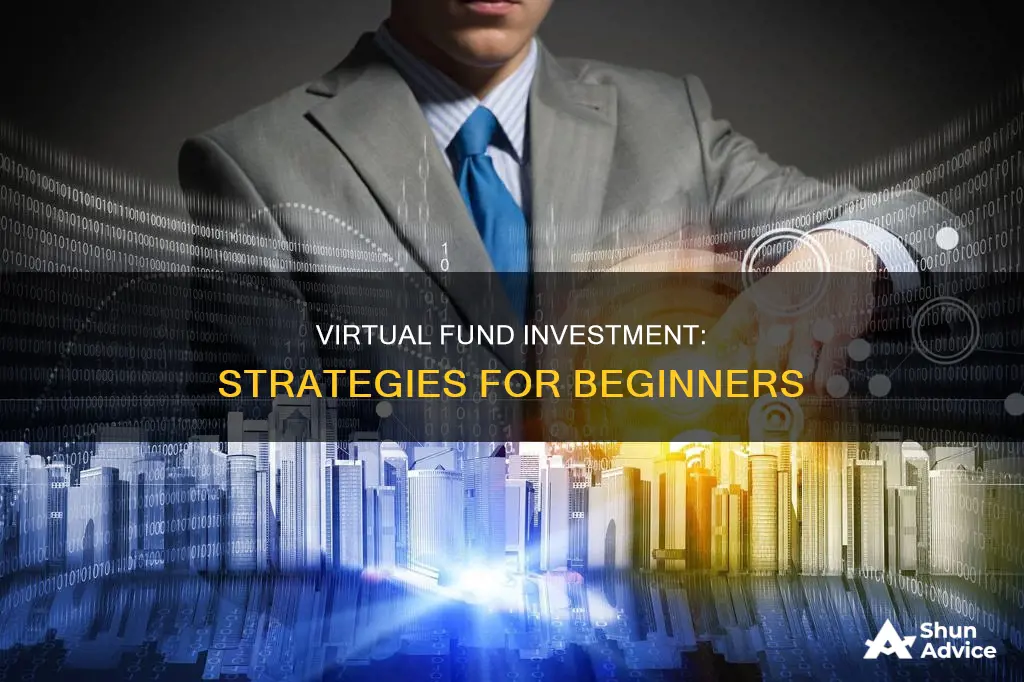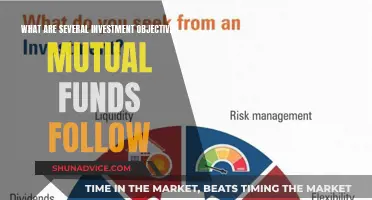
Virtual investing is a risk-free way to try out investing in stocks. With virtual investing, you use an online program to simulate the stock market and trade stocks, commodities, Forex, and options. This method allows you to become familiar with the software and discover how investing works without putting your money at stake. While virtual investing is a great way to build your skills and confidence, it's important to remember that your results may be less realistic than real-world investing because the absence of financial risk can lead to different decision-making.
| Characteristics | Values |
|---|---|
| What is virtual investing? | Using an online program to invest in stocks, commodities, Forex, and options |
| How to invest virtually? | Keep track of investments on paper or use online brokers to try investing without risk |
| Why should you consider virtual investing? | It's a risk-free way to train your skills and discover how investing works |
| Be careful with virtual investments! | Results may be overly positive due to the absence of real money at stake |
| Can anyone trade virtual stocks? | Yes, anyone can invest virtually, and if you are 18 or older, you can switch to investing with real money |
| What to watch out for with stocks? | Stocks move erratically and are influenced by news articles; you can speculate on these sudden movements |
| How to achieve better results with virtual investing? | Learn practical lessons that can be applied to real investments and keep track of mistakes to avoid repeating them |
What You'll Learn

Virtual investing 101
Virtual investing is a risk-free way to try out investing online. It involves using an online program to simulate the stock market and trade stocks, commodities, Forex, and options.
How to Invest Virtually
Some investors choose to keep track of their virtual investments on paper, but the rise of online brokers means that you can now try investing without risk. You can open a free demo account with a broker to try virtual investing for free.
Why You Should Consider Virtual Investing
Virtual investing is a great way to train your skills and become familiar with the software and how investing works. You can compare different strategies to discover which method of investing works best for you.
Be Careful with Virtual Investments
It's important to remember that virtual investing doesn't carry the same emotional weight as investing with real money, so the results you achieve may be overly positive. Your results may also be less realistic because you make different decisions when real money is at stake. Therefore, don't start investing large amounts immediately after trading with virtual money.
What to Watch Out For with Stocks
Stocks generally move more erratically than, for example, currency pairs. Because the stock market is smaller, an article in a reputable newspaper can have a big impact on a stock's price. By keeping an eye on the news, you can speculate on these sudden movements and quickly buy and sell stocks virtually.
How to Achieve Better Results with Virtual Investing
Virtual investing can help you invest more profitably by teaching you practical lessons that you can apply to your investments with real money. By keeping track of the mistakes you make, you can prevent yourself from making them again. It's important to invest realistically and always remember that investing is risky, and you can always lose your investment.
Invest in Index Funds with Your 401(k): A Beginner's Guide
You may want to see also

Augmented reality
AR is similar to virtual reality (VR) but instead of being immersed in a completely artificial environment, users interact with digital information overlaid on their real-world surroundings. Examples of AR include Google Maps, Snapchat filters, Pokémon Go, and IKEA's app that lets you visualise furniture in your home.
AR has practical applications in a range of industries, including:
Healthcare
AR can be used by surgeons to view a patient's insides superimposed over their body, helping them to identify important organs and blood vessels. AR headsets can also provide real-time translations for doctors and display vital information such as heart rate and blood pressure.
Education
AR can help students struggling with certain subjects by projecting 3D images that bring complex concepts to life. For example, an AR app could project 3D algebra equations onto a desk to help a student visualise how they work.
Manufacturing
AR can be used to provide instructions to workers on an assembly line, helping them to understand and follow complex directions. It can also be used for quality control purposes, enabling workers to identify defects and address problems.
Retail
Retailers can use AR to enhance the customer experience by providing customers with more information about products. For example, AR can allow shoppers to visualise what a piece of furniture would look like in their home before buying it.
Other uses
AR can be used in corporate training, entertainment, industrial manufacturing and maintenance, and marketing.
Investing in AR
AR is one of the hottest topics in tech right now, with nearly every major player investing heavily in research and development. In 2021, venture capitalists injected nearly $3.9 billion into VR/AR startups. As the technology matures, more use cases are emerging, driving up demand in several industries.
There are three types of companies involved in the AR industry:
- Hardware companies: These companies make the glasses, headsets, and other devices that run on AR applications. Examples include Magic Leap, Oculus, and Google Lens.
- Software companies: These companies create the applications that run on the hardware. Examples include Google, Apple, and Facebook.
- Infrastructure companies: For AR to reach its full potential, significant investment is needed in 5G networks, edge computing, and data analytics companies. Examples of companies investing in this area include Verizon and AT&T.
When considering which companies to invest in, it is important to look at the size and scope of the company, the team's experience in the AR field, and the product itself. It is also worth noting that investing in AR and VR companies is risky, as it is unclear whether these technologies will take off in a big way.
A Guide to Investing in Mutual Funds via Zerodha Kite
You may want to see also

Virtual reality
The global VR market is expected to grow at a compound annual growth rate (CAGR) of 14-31% from 2024 to 2030, with some sources estimating the growth rate to be as high as 27.5% from 2023 to 2030. This growth is driven by the increasing affordability of VR devices, the growing popularity of VR gaming, and the rise of enterprise applications for VR.
When considering investing in VR, it is important to look at both the pros and cons of this emerging technology.
Pros of investing in VR:
- VR has the potential to be a transformative technology, and investors who get in early could see significant returns.
- Many VR stocks are large-cap tech stocks, which are generally more stable investments than typical startups.
Cons of investing in VR:
- VR could turn out to be a passing fad rather than a long-term trend.
- VR stocks are sensitive to interest rate changes, as many big tech companies have substantial debt burdens that become more expensive to service when interest rates rise.
There are several ways to invest in VR, including:
- Individual VR stocks: Buying shares of individual VR companies can be a good option, but it is important to research the companies thoroughly before investing, as individual stocks can be risky.
- Exchange-traded funds (ETFs): ETFs like the ProShares Metaverse ETF (VERS) offer investors exposure to a diverse range of VR stocks with a single purchase.
- Options trading: More speculative investors may consider trading options on VR stocks, such as buying call options or selling puts if they expect the stock price to rise, or buying put options or selling covered calls if they anticipate a decline in the stock price.
- Meta Platforms (META): Formerly known as Facebook, Meta is a leader in VR technology with its Oculus VR platform. While VR is not its core business, Meta has made significant investments in this area, signalling its commitment to the metaverse.
- Sony Group Corp. (SONY): Sony entered the VR market in 2016 with its PlayStation VR headset and released an updated version, the PlayStation VR2, in 2023.
- Nvidia Corp. (NVDA): Nvidia is a leading designer of graphics processing units (GPUs) for gaming consoles and PCs, and its VR-specific GPUs are considered the best in the industry.
- Advanced Micro Devices Inc. (AMD): AMD is another well-known semiconductor company, focusing on AI and GPU technology, which are crucial for VR applications.
- Apple Inc. (AAPL): Apple recently entered the VR market with its Vision Pro headset, which is expected to launch in early 2024. While the high price tag may be a hurdle, Apple has a strong track record of winning significant market share with its consumer electronics.
These are just a few examples of VR stocks to consider, and there are many other companies working to develop and advance VR technology. As with any investment, it is important to carefully research and consider your financial goals and risk tolerance before investing in VR.
TSP Funds: Investing for the Future
You may want to see also

Virtual real estate
Getting Started
To get started with virtual real estate investing, you will need:
- A reliable internet connection
- A smartphone or phone line
- A basic home office setup
- A business plan for your target investment market
Platforms and Apps
There are many online platforms and apps that can be used for virtual real estate investing. Here are some examples:
- RoofStock: An online marketplace for purchasing rental properties
- FlipScout: A tool that uses data and AI to help investors make decisions
- Fundrise: A platform that sells e-REITs (a digital version of a traditional REIT)
- Matterport: An app that allows users to create 3D property renderings
- Dealcheck: An app that helps users find properties suited for renovation and provides a database of properties for rental property investment
- Airbnb: A useful app for investors looking to purchase property in an area with consistent tourist traffic
Advantages
- It opens up opportunities across the world
- It saves time and energy as investors don't need to travel to the physical location
- Investors can run multiple projects simultaneously
Disadvantages
However, there are also some disadvantages to consider:
- Investors can't always respond to problems themselves and need to rely on local help
- More research is required to understand the local market
- Virtual real estate investing puts you at the mercy of other real estate professionals, such as contractors and agents
Techniques
There are several techniques that can be used for virtual real estate investing:
- Virtual wholesaling: Locating an investment property, getting it under contract, and assigning the sales contract to a third-party investor
- Real estate syndications: Investing in large-scale projects like storage unit buildings or apartment complexes
- Virtual real estate crowdfunding: Pooling resources with a group of individuals to fund a real estate project
- Buying rental properties: Utilizing long-term and short-term rental strategies, such as Airbnb or VRBO
- Virtual house flipping: Purchasing and fixing up a home in an area outside of your local market
- Real estate investment trusts (REITs): Investing in publicly-traded companies that operate and invest in income-producing real estate
- Peer-to-peer or hard money lending: Becoming a lender and providing capital to other real estate investors at higher interest rates
A Guide to Investing in 401(k) Mutual Funds
You may want to see also

Virtual stock trading
The TD Bank Virtual Stock Market Game is designed for both classroom and individual use. It offers tutorial videos, advanced research tools, and lesson plans for teachers. It also provides real-time rankings so students can compare their performance with their classmates and other students across the country.
The MarketWatch Virtual Stock Exchange is intended for individuals aged 16 and older. It offers a variety of features, including the ability to create custom games, enable advanced options like limit and stop-loss orders, build and monitor watchlists, and set the starting budget. The platform also provides news and research tools to help users decide which stocks to include in their portfolios.
Both platforms use virtual cash, allowing users to gain experience and build confidence in their trading abilities before entering the real stock market.
Dividend Funds: A Smart Investment Strategy for Long-Term Gains
You may want to see also
Frequently asked questions
Virtual investing is a way to invest using an online program. You can try out the possibilities without any financial risk. The stock market is simulated, and you can trade in stocks, commodities, Forex, and options.
You can choose to virtually invest in the traditional way by keeping track of your investments on paper. However, a better way is to use an online broker to try investing without any risk. You can open a free demo account with a broker to try virtual investing for free.
Virtual investing is a great way to train your skills and become familiar with the software and discover how investing works. You can also compare different strategies to see which method of investing works best for you.
Some traders become overconfident due to the results they achieve with virtual investments. Since there is no real money at stake, you experience fewer negative emotions. Your results may be less realistic because you make different decisions when real money is involved. Therefore, do not start investing a large amount after trading with virtual money.
Yes, anyone can trade virtual stocks. If you are 18 or older, you can switch to investing with real money.







